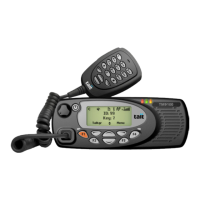TM9100 Service Manual Description 55
© Tait Electronics Limited August 2005
2.6.1 Audio Processing and Signaling
Microphone Input The input to the transmitter path begins at the microphone input. There are
two microphone sources: a fist microphone connected to the control head
and an auxiliary microphone connected via the auxiliary or external options
connector. Only electret-type microphones are supported. Support for
optional dynamic fist microphones is facilitated by a hardware amplifier and
filter in the control head, and must be activated in the programming
software.
Analog Processing
of the Microphone
Input
The CODEC (AD6521) performs microphone selection and amplification.
The microphone amplifier consists of a fixed gain amplifier of 16dB
followed by a programmable-gain amplifier with 0 to 22dB gain.
The amplified microphone signal is converted to a digital stream by a 16-bit
ADC with integral anti-alias filtering (0.1 to 3.2kHz). The digital stream is
transported to the DSP for further audio processing.
Automatic Level
Control
The ALC follows and is used to effectively increase dynamic range by
boosting the gain of the microphone pre-amplifier under quiet conditions
and reducing the gain under noisy acoustic conditions. The ALC function
resides in the DSP and controls the microphone-programmable gain
amplifier in the CODEC. The ALC has a fast-attack (about 10ms) and
slow-decay (up to 2s) gain characteristic. This characteristic ensures that the
peak signal level is regulated near full scale to maximize dynamic range.
DSP Audio
Processing
(Analog Mode)
The output of the automatic level control provides the input to the DSP
audio processing chain at a sample rate of 8kHz. Optional processing such
as encryption or companding is done first if applicable. Pre-emphasis, if
required, is then applied. The pre-emphasized signal is hard limited to
prevent overdeviation and filtered to remove high frequency components.
The sample rate is then interpolated up to 48kHz and scaled to be suitable
for the frequency synthesizer.
Data and Signaling
Encoders
(Analog Mode)
The data and signaling encoders inject their signals into various points
within the audio processing chain. The injection point depends on the
encoders bandwidth and whether pre-emphasis is required.
Tx Vocoder
(Digital Mode)
The IMBE vocoder block takes audio samples in blocks of 20ms, analyses
them and compresses them down to 88 bits. If there is no speech content in
the segment, the vocoder produces silence. If speech is detected in the
segment, the content of the segment is split into a variable number of
frequency bands (max. 12) and a voiced/unvoiced decision is made for each
band. It also estimates the pitch of the segment of speech and determines the
spectral amplitudes of the voiced frequency bands.

